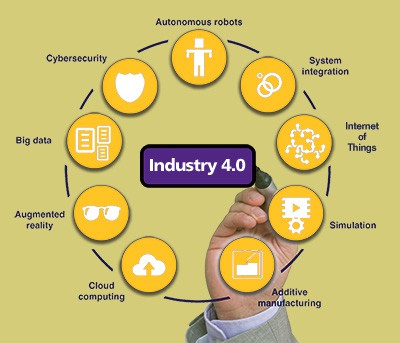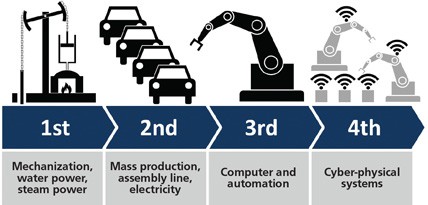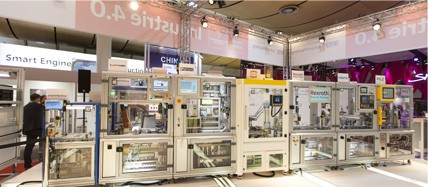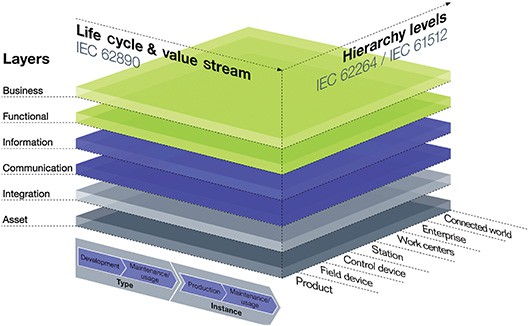This article was written by Bill Lydon, automation industry authority, journalist and former chief editor at InTech magazine.
Industry 4.0 is a holistic automation, business information, and manufacturing execution architecture to improve industry with the integration of all aspects of production and commerce across company boundaries for greater efficiency. The term Industry 4.0 originated in Germany, but the concepts are in harmony with worldwide initiatives, including smart factories, Industrial Internet of Things, smart manufacturing, and advanced manufacturing.
Birth of Industry 4.0
The Industry 4.0 initiative started as one part of a 10-point high-tech German strategic plan created in 2006. On 14 July 2010, the German cabinet decided to continue the strategy by introducing the High-Tech Strategy 2020 initiative focusing the country’s research and innovation policy on selected forward-looking projects related to scientific and technological developments over ten to fifteen years. Industry 4.0 is a vision of integrated industry implemented by leveraging computing, software, and Internet technologies. The 4.0 refers to the idea of a fourth industrial revolution:
- First: production mechanization using water and steam power
- Second: mass production (Henry Ford often cited as the innovator)
- Third: digital revolution (e.g., machine tool numerical control, programmable logic controllers, direct digital control, and enterprise resource planning)
- Fourth: Industry 4.0 leveraging cyber-physical systems, embedded computing, Internet of Things technologies
The German strategy emphasizes cooperation between industry and science to promote closer links between knowledge and skills. The final report of the Industrie 4.0 working group, Recommendations for Implementing the Strategic Initiative INDUSTRIE 4.0, describes using Internet of Things technologies, communications, and web services in manufacturing.
They make it possible to create networks incorporating the entire manufacturing process that convert factories into smart environments. Linkages include smart machines, warehousing systems, and production facilities that feature end-to-end integration, including inbound logistic, production, marketing, outbound logistics, and service. Industry 4.0 is projected to create closer cooperation between business partners (e.g., suppliers and customers) and between employees, providing new opportunities for mutual benefit.

Vision
The vision of Industry 4.0 is significantly higher productivity, efficiency, and self-managing production processes where people, machines, equipment, logistics systems, and work-in-process components communicate and cooperate with each other directly. A major goal is the application of low-cost mass production efficiencies to achieve make-to-order manufacturing of quantity one by leveraging embedded processing and communications.
Production and logistics processes are integrated intelligently across company boundaries, creating a real-time lean manufacturing ecosystem that is more efficient and flexible. This will facilitate smart value-creation chains that include all of the life-cycle phases of the product from the initial product idea, development, production, use, and maintenance to recycling. In this way, the ecosystem can use customer wishes for everything from product idea to recycling to be responsive and continually make improvements.
 Industry 4.0, showing the four “industrial revolutions”
Industry 4.0, showing the four “industrial revolutions”
Networking companies in the supply chain make it possible to optimize individual production steps and the entire value chain. For example, comprehensive real-time information enables companies to react during production to the availability of certain raw materials based on price, quality, and other factors for optimal efficiency. External linkages enable production processes to be controlled across company boundaries to save resources and energy.
The digitization of industry is forecasted to foster new business models and present great opportunities for small- and medium-size enterprises. This is already starting to happen. For example, to build low-volume metal parts, companies build virtual 3D models and use direct metal laser sintering (DMLS), an additive process similar to 3D printing that deposits metal powder layers melted by laser, to create parts. These parts are fully dense metal with excellent mechanical properties. Interestingly, the DMLS process can produce complex geometries that traditional machining processes are not capable of creating.
Asynchronous manufacturing
Traditional assembly manufacturing lines are synchronous, with predefined workflows based on production work orders running in enterprise business systems. Production steps are centrally communicated to each manufacturing station synchronized with the assembly line. In contrast, Industry 4.0 is based on asynchronous manufacturing, with components in the production flow using auto identification technology to inform each machine and operator what needs to be done to produce the customized end product at each step of the production process.
The use of new flexible machines that adapt to the requirements for the part being made is another dimension of Industry 4.0. This achieves a highly flexible, lean, and agile production process enabling a variety of different products to be produced in the same production facility. Profitable mass customization allows the production of small lots (even as small as single unique items) due to the ability to rapidly configure machines to adapt to customer-supplied specifications and additive manufacturing.
Analytics
Industry 4.0 systems capture a wide range of data that can be used to improve performance and productivity with the application of analytics. Analytics are used in a number of ways, including real-time predictive maintenance, which helps manufacturing companies avoid interruption of production by unplanned machine failures on the factory floor—directly improving asset utilization. Another application is optimization of production operations, improving productivity and energy efficiency.
Technology
The implementation of the Industry 4.0 vision is becoming possible with dramatic technological advances driven by the Internet of Things, including open software platforms, open communications, open data models, and powerful embedded processors. Industry 4.0 uses the term cyber-physical systems (CPS) to describe the interaction of physical and computing, including embedded intelligence at all levels, including machines, sensors, actuators, production parts, subassemblies, and products being produced. CPS are composed of physical entities, such as mechanisms controlled or monitored by computer-based algorithms. A current example of the application of CPS is mechatronic drive systems that use processors and communications embedded in motor drives to accomplish coordinated operations in a packaging machine without physical gearing. This saves significant cost, providing greater flexibility and improved reliability.
Competitive driver
A driving force motivating the adoption of greater manufacturing and process automation worldwide is the realization that pursuing low labor rates is no longer a winning strategy. Remaining competitive and flexible can only be accomplished by leveraging the latest technologies, with automation a fundamental component for this transition to be successful. The adoption of new technology during times of significant innovation is critical for manufacturing success. History tends to repeat itself; consider the automobile, a plaything of the rich at the beginning of the 20th century.
Henry Ford was determined to build a simple, reliable, and affordable car, which resulted in the Model T Ford produced with Ford’s revolutionary assembly line. Ford continued refining assembly line methods, reducing the production time of a Model T from more than 12 hours to 93 minutes. By 1914, Ford commanded a 48 percent share of the automobile market. Competitors had to implement assembly lines, or risk going broke because they could not compete. The competitive landscape is not static, as evidenced by the loss of market share by the U.S. automotive industry. In 1960, 48 percent of all automobiles were produced in the U.S. By 1997, the number was down to 23 percent, more than a 50 percent loss of market share. By 1997, Japan produced 21 percent of automobiles.
Success of the Japanese automotive manufacturers was attributed to advanced manufacturing methods, aggressive automation, and aggressive use of robotics (Japan currently has 323 robots per 10,000 people). During that same time frame, U.S. automakers had access to the same technologies and methods, but did not take advantage of them until compelled by economic factors. Manufacturers around the world are recognizing the need for more automation to efficiently produce products with precision and consistent quality. For example, in 2014 China was the single largest market for industrial robot sales, according to the International Federation of Robotics. Based on the present rate of robot adoption, it appears that within two years there will be more industrial robots in Chinese factories than the European Union or the U.S.
Historic perspective: Cooperation essential
Industry has pursued integration since the 1980s. The most prominent concept, termed computer integrated manufacturing, integrates the total manufacturing enterprise to increase manufacturing productivity and efficiency. The vision electronically links and coordinates functional areas, including design, analysis, planning, purchasing, cost accounting, inventory control, CNC machines, and materials handling.
The Manufacturing Automation Protocol (MAP) released in 1982 defined a computer network standard for interconnection of devices from multiple manufacturers to combat the proliferation of incompatible communications standards used by suppliers of automation products such as programmable controllers. In 1986, the Boeing corporation merged its Technical Office Protocol with the MAP standard, and the combined standard was referred to as MAP/TOP.
Although promoted and used by manufacturers, such as General Motors, Boeing, and others on a small number of projects, it was cumbersome and expensive with the available technology. A major challenge was the integration of components from different suppliers, including programmable logic controllers, CNC machine tools, conveyors, and robots using different communications protocols. There were also competing data interchange and protocol standards between the U.S. and Europe, which was counterproductive.
Worldwide adoption
Germany’s Industry 4.0 initiative is influencing thinking throughout the world, which in turn influences other initiatives and cooperative efforts.
Made in China 2025 initiative and Industry 4.0
China has embraced the fourth industrial revolution concept as part of a 10-year plan, “Made in China 2025,” an initiative to comprehensively upgrade Chinese industry with the goal to catch up with production powerhouses like Germany and fend off competition from other developing countries with lower labor costs. The plan focuses on 10 sectors, including high-end computerized machinery and robotics, aerospace equipment, renewable-energy cars, and biological medicine.
The German Federal Ministry for Economic Affairs and Energy (BMWi) and the Chinese Ministry of Industry and Information Technology signed a memorandum of understanding on cooperation between the two countries in the field of Industry 4.0. The memorandum links the BMWi’s Industry 4.0 with the Chinese initiative “Made in China 2025,” thereby strengthening the innovation partnership between the two countries. China recognizes remaining competitive means embracing automation.
This is illustrated by Changying Precision Technology Company’s factory in Dongguan city, north of Shenzhen; it is the first “unmanned” factory run by computer-controlled robots, numerical control machining equipment, unmanned transport trucks, and automated warehouse equipment. Six hundred human assembly-line workers were replaced with automation, resulting in a fivefold reduction in manufacturing errors and an increase in production of more than 250 percent.
Japan
The manufacturing industry accounts for a large portion of gross domestic product in Japan. Japanese companies and organizations, including the Ministry of Economy, Trade and Industry, are looking toward Internet of Things technologies and Industry 4.0 concepts as part of their Industrial Value Chain Initiative (www.iv-i.org) strategy for manufacturing in the future. The initiative states that “The Industrial Value Chain Initiative is a forum to design a new society by combining manufacturing and information technologies, and for all enterprises to take an initiative collaboratively.” Goals include:
- giving the manufacturing industry service models using their products as key competitive components
- reducing cost and increase flexibility of manufacturing operation management software by platforms
- connecting small- and medium-size manufacturers in a supply/engineering chain, resulting in high quality and productivity
Make in India
“Make in India” was launched by Prime Minister Narendra Modi in 2014 to promote the growth of India’s manufacturing industry. “Make in India” is an initiative of the government of India to encourage multinational, as well as domestic, companies to manufacture their products in India. India made this announcement globally as the partner country at the 2015 HANNOVER MESSE. India intends to leverage Industry 4.0 concepts and new technology in initiatives for manufacturing, smart cities, and overall infrastructure as part of the country’s Digital India initiative.
 Source: SmartFactoryKL
Source: SmartFactoryKL
Smart Manufacturing Leadership Coalition
The Smart Manufacturing Leadership Coalition (SMLC) was founded in the U.S. to overcome the costs and risks associated with the commercialization of smart manufacturing systems. The SMLC has not explicitly embraced Industry 4.0, but its vision and mission embrace many of the same concepts. The SMLC mission is to lead the industrial sector transformation into a networked, information-driven environment in which an open, smart manufacturing platform supports real-time, high-value applications for manufacturers.
The mission is to optimize production systems and value chains, and radically improve sustainability, productivity, innovation, and customer service. SMLC intends to develop a cloud-based, open architecture manufacturing infrastructure and marketplace through the collaboration of manufacturing thought leaders across industry, academia, consortia, and government. SMLC’s goals include integrating plant-level systems and data, accelerating the development and deployment of reusable applications, providing an open and secure infrastructure accessible and affordable to all, and embracing evolving business needs and new market opportunities agilely.
Standards
Industry 4.0 and related initiatives recognize that efficiently building self-managing production processes requires open software and communications standards that allow sensors, controllers, people, machines, equipment, logistics systems, and products to communicate and cooperate with each other directly. Future automation systems must adopt open source multivendor interoperability software application and communication standards similar to those that exist for computers, the Internet, and cell phones. Industry 4.0 demonstrations acknowledge this by leveraging existing standards, including the ISA-88 batch standards, ISA95 enterprise-control systems integration standards, OPC UA, IEC 6-1131-3, and PLCopen.
The harmonization of standards worldwide recently took another step forward when representatives of the German alliance Platform Industrie 4.0 and the U.S.-based Industrial Internet Consortium met in Zurich, Switzerland, in March 2016 to explore the potential alignment of their two architecture efforts—respectively, the Reference Architecture Model for Industrie 4.0 (RAMI4.0) and the Industrial Internet Reference Architecture (IIRA). The OPC Foundation and Object Management Group (OMG) established a collaborative strategy for technical interoperability that encompasses the OPC Unified Architecture (OPC UA) and the OMG Data Distribution Service (DDS) standard. These are significant cooperative efforts that illustrate maturity in the industrial automation industry. They recognize that manufacturing has worldwide interdependencies requiring common standards and interoperability.
Industry 4.0 process automation
The application of Industry 4.0 concepts for process automation is emerging with the new NAMUR working group addressing experience exchanges, concept developments, and formulating requirements for the following topics:
- identification of opportunities and potentials for production today and in the future
- description of the requirement of Industry 4.0 approaches from the perspective of NAMUR
- positioning of NAMUR in Industry 4.0 activities
In cooperation with the Association of German Engineers and the Association for Electrical, Electronic & Information Technologies,NAMUR published The New Technology Roadmap “Process Sensors 4.0.” The technology road map identifies the necessary requirements, as well as the communication functions for process sensors from a simple temperature sensor up to complex devices. Functions include connectivity and communication with a unified protocol, maintenance and operating functions, traceability and compliance, a virtual description to support continuous engineering, and interoperability.
A core concept is processing embedded in sensors that communicate with control systems and directly with enterprise systems. The application of Industry 4.0 process automation was demonstrated by the vendors at the 2015 HANNOVER MESSE. They focused on three distinct aspects of Industry 4.0 in process automation: vertical integration with linkages from field-level devices to business control; horizontal integration to optimize value chain outputs; and end-to-end engineering, planning, and process control.
Industry 4.0 demonstration system
SmartFactoryKL and the German Research Center for Artificial Intelligence, along with 18 partners, have been demonstrating a working production line that illustrates Industry 4.0 concepts at industry events, including HANNOVER MESSE in Germany. The demonstrator illustrated how market-ready technologies were applied to create a flexible Industry 4.0 production line.
SmartFactoryKL is a manufacturer-independent demonstration and research platform in which innovative information and control technologies and their use in a realistic industrial production environment are tested and developed. SmartFactoryKL illustrates the vision of the factory of the future. Diverse components of different manufacturers are connected with each other to work in harmony. Intelligent components are able to take over independently contextual tasks and to work self-sufficiently, delivering customized products leveraging mass-production techniques.
 Reference architecture model for Industry 4.0 (RAMI4.0). Source: ZVEI
Reference architecture model for Industry 4.0 (RAMI4.0). Source: ZVEI
Automation professionals
The role of automation professionals continues to grow in importance with the increasing sophistication and integration of automation.
About the Author
Bill Lydon is an automation industry expert, author, journalist and formerly served as chief editor of InTech magazine. Lydon has been active in manufacturing automation for more than 25 years. He started his career as a designer of computer-based machine tool controls; in other positions, he applied programmable logic controllers and process control technology. In addition to experience at various large companies, he co-founded and was president of a venture-capital-funded industrial automation software company. Lydon believes the success factors in manufacturing are changing, making it imperative to apply automation as a strategic tool to compete.
A version of this article also was published at InTech magazine.




